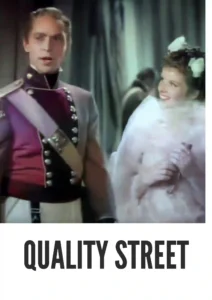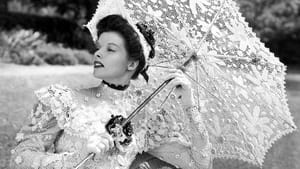Contact: info@alwanfilm.com
Video Sources 0 Views

Synopsis
Quality Street 1937 Colorized Review: Romance and Wit Reimagined in Color

Introduction
Quality Street (1937), directed by the legendary George Stevens, is a delightful romantic comedy that captures the charm and wit of early 20th-century cinema. Adapted from J.M. Barrie’s 1901 play, Quality Street tells the story of love, mistaken identities, and societal expectations in early 19th-century England. Initially released in black and white, this early film has since been reintroduced in color, offering modern audiences a new way to experience its visual and narrative elegance. This article explores the cultural impact of Quality Street, the significance of its colorized version, and its place in the broader history of romantic comedies in film.
Check The Full Colorized Movies List
Check Our Colorized Movies Trailer Channel
Understanding Quality Street 1937 Colorized: Director, Cast, and Genre
Director’s Vision
Quality Street (1937) is another testament to George Stevens’ directorial genius. Known for his exceptional versatility, Stevens navigated the romantic comedy genre with the same attention to detail and visual flair that he brought to his Westerns and dramas. In Quality Street, Stevens’ focus was on creating a refined and heartfelt romantic comedy that retained the original play’s wit and sophistication while capturing the period’s essence. His vision extended to detailed period-appropriate sets and costumes, along with a nuanced focus on the social dynamics of early 19th-century England. Stevens’ unique approach helped establish Quality Street as an endearing classic with a timeless story.
Iconic Cast Performances
The heart of Quality Street lies in its stellar performances, led by Katharine Hepburn in the role of Phoebe Throssel. Hepburn, known for her wit, intelligence, and strong screen presence, shines as the spirited Phoebe, a woman navigating love, disappointment, and social expectations. Hepburn’s performance is both tender and humorous, capturing the character’s vulnerability and resilience with remarkable depth.
Supporting Hepburn is Franchot Tone, who plays Dr. Valentine Brown, Phoebe’s love interest. Tone’s portrayal of Brown is sincere and charming, making him a fitting romantic lead alongside Hepburn. Together, they bring chemistry and charisma to the screen, which elevates the film’s romantic and comedic elements.
The Romance-Comedy Genre
Quality Street (1937) fits squarely within the romance-comedy genre, with its emphasis on relationships, humor, and social situations. However, unlike many romantic comedies, Quality Street explores themes of societal pressure, female independence, and self-worth. These elements provide a rich backdrop for the comedic and romantic moments, making the film both entertaining and thought-provoking.
Exploring the World of Quality Street 1937 Colorized: Plot and Characters
Detailed Synopsis
Set in a quaint English village during the early 19th century, Quality Street centers on Phoebe Throssel (Hepburn), a young woman who falls in love with the dashing Dr. Valentine Brown (Tone). When Brown leaves to serve in the Napoleonic Wars, Phoebe is heartbroken. She spends the next ten years waiting for his return, only to discover that her youthful beauty has faded, and she is now viewed as an “old maid.”
To reclaim her youth and perhaps reignite Brown’s interest, Phoebe invents an alter ego—her “younger” and flirtier self, “Livvy.” With this disguise, Phoebe navigates a series of comedic and romantic encounters, leading to a delightful mix of misunderstandings, mistaken identities, and romantic entanglements.
Supporting characters, including Phoebe’s sister Susan (Fay Bainter) and other townsfolk, contribute humor and depth to the story. Each character plays a crucial role in Phoebe’s journey, adding layers to the film’s exploration of love, societal expectations, and self-perception.
The Art of Film Colorization
Understanding the Process
Colorizing black-and-white films involves adding hues to grayscale images to create the illusion of a full-color production. This can be achieved through manual coloring, where each frame is painted by hand, or through advanced digital techniques that use software to match tones and enhance details. Colorization demands a careful balance of historical accuracy and aesthetic appeal, as even minor discrepancies in color choice can disrupt a film’s authenticity.
The colorization of Quality Street required meticulous work to match the film’s period settings and costumes. The goal was to retain the charm and elegance of the original black-and-white version while bringing out details that were previously hidden. By enhancing the visual elements, colorization helps viewers appreciate the intricacies of the set design, costumes, and performances.
Development Over Time
The colorization of films has evolved significantly over the years. Early methods of adding color were often rudimentary, involving tinted frames or manually colored scenes. Technological advances, however, have allowed filmmakers to create more refined and realistic colorized versions, making films like Quality Street (1937) accessible to contemporary audiences with new vibrancy. Today, colorized films are viewed as a way to bridge the gap between classic cinema and modern preferences, providing audiences with fresh perspectives on timeless stories.
Early Colored Films: A Brief History
The Emergence of Color in Cinema
The desire to add color to films began early in cinema history. Pioneering techniques such as tinting, toning, and hand-painting were used to introduce color into select scenes. By the 1930s, Technicolor became a groundbreaking technology that allowed for full-color films, revolutionizing the industry and changing audience expectations.
Colorization of previously black-and-white films began to gain traction in the mid-20th century, as filmmakers sought to reach younger audiences and add a new dimension to older classics. For films like Quality Street (1937), colorization offers an opportunity to appreciate the film’s period details in a way that might not have been possible in its original black-and-white format.
Quality Street 1937 and Its Early Colored Version
Why Colorize Quality Street?
The decision to colorize Quality Street (1937) was driven by a desire to reintroduce the film to modern viewers and offer a fresh viewing experience. By adding color, the creators aimed to enhance the film’s appeal while staying true to its historical setting. The colorization brings out the intricate costumes, set designs, and character expressions, allowing audiences to appreciate the film’s aesthetic richness.
Impact on Visual Narrative
The colorized version of Quality Street highlights the visual aspects that were not as pronounced in black and white. The costumes, which reflect the fashion of the early 19th century, become more vibrant, while the setting, including the quaint village streets and elegant ballrooms, takes on a new level of realism. This added visual layer invites viewers into Phoebe’s world in a way that enhances the romantic and comedic elements of the story. However, colorization can also raise questions about altering the director’s original vision, as the shift from black-and-white to color can change the film’s mood and tone.
The Debate Over Film Colorization
Arguments For and Against
Film colorization has sparked ongoing debate in the film community. Critics argue that colorizing black-and-white films can undermine the original artistic choices of directors and cinematographers. Black-and-white cinematography often relies on lighting, shadows, and contrast to create mood and depth, and adding color can sometimes disrupt this balance.
On the other hand, advocates of colorization view it as a way to bring classic films to new audiences, enhancing their appeal and preserving their legacy. They argue that colorized versions can offer insights into historical settings, costumes, and character details, making the stories more accessible for contemporary viewers.
Examining Quality Street 1937 as an Early Colored Film
Enhancement or Distraction?
The colorization of Quality Street (1937) offers a unique opportunity to examine the impact of color on the viewer’s experience. For some, the colorized version brings new life to the story, making the period details more engaging. Others may find that the added colors detract from the film’s charm, preferring the softer, more timeless look of the original black-and-white.
In the case of Quality Street, colorization may enhance viewers’ appreciation of the setting and costumes, aligning with the romantic and historical themes of the film. However, whether this enhancement is necessary or desirable remains a matter of personal preference.
Influence and Legacy: Quality Street 1937 Colorized’s Impact on Romantic Comedy
Setting the Stage for Future Rom-Coms
Quality Street (1937) has had a lasting influence on the romantic comedy genre, helping to establish conventions such as mistaken identities, misunderstandings, and the interplay of wit and romance. The film’s success demonstrated the potential of romantic comedies that combine humor with thoughtful explorations of social expectations.
Subsequent films have drawn inspiration from Quality Street, both in terms of storytelling and character dynamics. Its influence can be seen in later romantic comedies that focus on strong, witty female protagonists and themes of love and self-discovery.
Director’s Cinematic Legacy: Beyond Quality Street 1937 Colorized
George Stevens’ Enduring Influence
George Stevens’ contributions to cinema extend far beyond Quality Street. His directorial career includes films like Swing Time (1936), Giant (1956), and A Place in the Sun (1951), which showcase his versatility across genres. Stevens is remembered for his ability to bring humanity and depth to his characters, as well as his innovative techniques that continue to influence filmmakers today.
Stevens’ impact on film is evident in his unique approach to storytelling, which combines humor, drama, and a keen eye for visual detail. His work remains a source of inspiration for directors who seek to blend entertainment with thoughtful narratives.
Themes Explored in Quality Street 1937 Colorized
Love, Identity, and Social Expectations
At its core, Quality Street (1937) is a story about love, identity, and the pressures society places on individuals. Through Phoebe’s transformation into her alter ego, the film explores themes of self-worth, societal roles, and the lengths people go to for love and acceptance. These themes resonate with audiences today, as they address universal human experiences.
Reception and Controversy Surrounding Quality Street 1937 Colorized
Initial Reviews and Audience Reactions
Upon its release, Quality Street (1937) was praised for its humor, charm, and the chemistry between Hepburn and Tone. However, the colorized version faced some backlash, as purists argued that the added colors disrupted the film’s original mood and atmosphere. Nonetheless, the colorized version has also attracted viewers who appreciate the enhanced visuals.
Where to Watch Quality Street 1937 Colorized Online
Quality Street (1937) is available on various streaming platforms, including Amazon Prime and Criterion Channel, where audiences can enjoy both the original black-and-white version and the colorized release.
FAQs About Quality Street 1937 Colorized
Q: Who directed Quality Street (1937)?
A: George Stevens directed the film, known for his work across genres.
Q: What is the significance of the colorized version?
A: It offers a fresh visual experience that enhances the period details of the story.
Q: What themes are explored in the film?
A: Love, self-worth, societal expectations, and mistaken identities are key themes.
Conclusion
Quality Street (1937) remains a timeless romantic comedy with its endearing performances, witty dialogue, and exploration of societal themes. Whether in black-and-white or color, the film captures the charm of classic cinema, inviting audiences to experience the story in all its warmth and humor.














